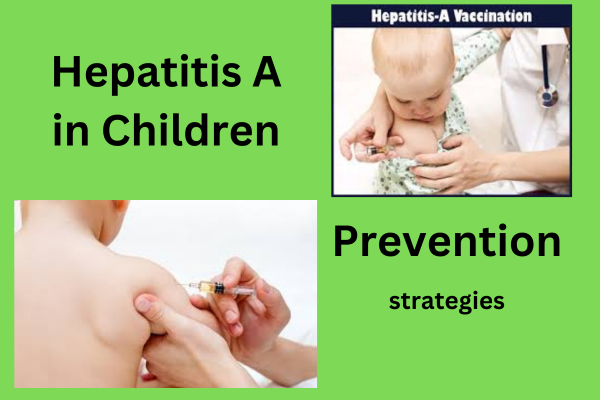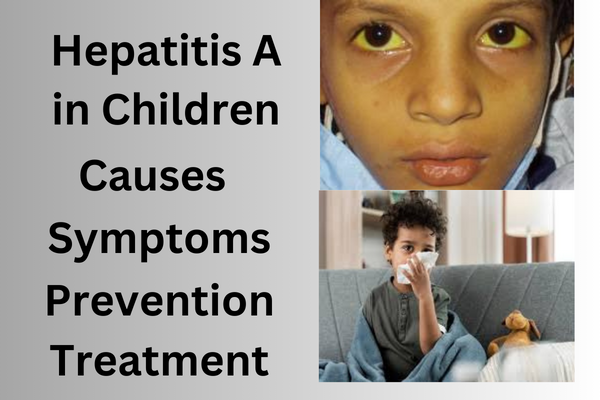Table of Contents
Togglewhat is hepatitis?
Hepatitis is a medical condition characterized by inflammation of the liver. The inflammation can be caused by various factors, including viral infections, toxins, certain medications, and autoimmune diseases.There are several types of viral hepatitis, including hepatitis A, B, C, D, and E. The most common cause of hepatitis is viral infection.We will discuss here hepatitis A in children.
Hepatitis A in children:
Hepatitis A is relatively common in children for a number of reasons, primarily related to the modes of transmission and the behaviors and environments typically associated with childhood.
The main factors in the high prevalence of hepatitis A in children are:
Fecal-oral transmission:
Verbal exploration in young children: Infants and toddlers explore their environment through verbal activities, such as putting objects or hands in their mouths. This behavior increases the chance of virus entry if contaminated objects or surfaces are encountered.
Limited awareness of hygiene: Young children may have limited understanding and awareness of proper hygiene practices, including hand washing. This lack of awareness can result in the unwitting introduction of the virus, especially in settings where hygiene standards may be difficult to consistently maintain.
Close personal contact:
Child care settings and schools: In environments such as daycare centers, schools and playgroups, where close personal contact is common, the virus can easily spread to children. Sharing toys, shared spaces, and frequent physical contact contribute to hepatitis A transmission.
High household density: In households with more than one family member, including other children, close quarters and shared spaces increase the risk of person-to-person transmission if one family member is infected.
Shared Living Spaces:
Shared living arrangements: Children often share living spaces, bedrooms and bathrooms. In such a communal environment, the virus can easily spread through shared surfaces and personal items.
Common use of facilities: Shared facilities in schools, recreational areas, and public spaces provide ample opportunities for virus transmission, especially if these spaces are not properly cleaned and disinfected.
Behavioral factors:
Limited personal hygiene practices: Children may have poor personal hygiene routines, including hand washing, which is an important preventive measure for hepatitis A. The virus can be present on surfaces or objects touched by an infected person.
Close contact during play: Playful behaviors, including physical contact, sharing toys, and engaging in activities that involve intimacy, can facilitate the spread of the virus among children.
Travel and exposure to local areas:
Family travel: Families with children can travel to areas where hepatitis A is more common. In such areas, exposure to contaminated food, water, or environmental surfaces may occur, leading to infection.
Immature Immune System:
Limited immunity in younger age groups: Children, especially those under 6 years of age, may have less developed immune systems than adults. This can make them more susceptible to infections, including hepatitis A.
Signs and symptoms of hepatitis A in children: recognizing telltale indicators

Hepatitis A, caused by the hepatitis A virus (HAV), can present with a variety of signs and symptoms in children. While some children may experience mild illness or even no symptoms, others may show more pronounced symptoms. Recognizing these signs is critical for prompt diagnosis and appropriate medical intervention. Here is a detailed study of the signs and symptoms of hepatitis A in children:
Jaundice (yellowing of the skin and eyes):
One of the prominent symptoms of hepatitis A is jaundice, yellowing of the skin and whites of the eyes. It is caused by the accumulation of bilirubin, a yellow pigment, in the bloodstream as a result of inflammation of the liver.
Fatigue:
Children with hepatitis A often experience constant fatigue and weakness. This can affect their energy levels, daily activities and overall health.
Abdominal pain:
Abdominal discomfort or pain is a common symptom of hepatitis A. Children may complain of abdominal pain or tenderness.
Nausea and vomiting:
Hepatitis A can cause gastrointestinal symptoms, including nausea and vomiting. Children may experience these symptoms, which lead to loss of appetite.
Fever:
An increase in body temperature is a common response to viral infection, and hepatitis A is no exception. Children with the infection may have a fever, which makes them feel uncomfortable.
Dark urine:
Hepatitis A can affect the color of urine, making it darker than normal. This change is caused by the presence of bilirubin in the urine, which is a result of liver damage.
Yellow stools:
Children with hepatitis A may have yellow or clay-colored stools. This change in stool color is another result of disruption of bilirubin processing by the liver.
Loss of appetite:
Hepatitis A can cause a significant loss of appetite in children. A combination of nausea, abdominal discomfort, and other symptoms can cause a loss of appetite.
Flu-like symptoms:
In the early stages, the symptoms of hepatitis A may resemble the flu. Children may experience headaches, muscle aches, and generally feel sick.
Itchy:
In some cases, children with hepatitis A may develop a rash, which is related to the accumulation of bile salts in the bloodstream due to liver damage.
Arthritis:
Joint pain, although less common, can be a symptom of hepatitis A in children. This can contribute to overall discomfort and affect mobility.
It is important to note that the severity and combination of symptoms can vary widely among affected children. Some may have a mild illness with few noticeable symptoms, while others may have a more significant impact on their health.
Hepatitis A prevention strategies and treatment in children: protecting children’s health
Hepatitis A, a viral infection that affects the liver, can be a significant health problem for children. Implementing effective prevention strategies and providing appropriate treatment is essential to manage and reduce the impact of hepatitis A in the pediatric population.
Prevention Strategies:
Vaccination:

Routine Vaccination: Vaccination is a cornerstone of hepatitis A prevention. The Centers for Disease Control and Prevention (CDC) recommends routine vaccinations for children, usually starting at age 1. A second dose is given six months later to ensure long-lasting immunity.
Catch-up vaccination: Children who have not been previously vaccinated can receive the hepatitis A vaccine at any age. This catch-up vaccination is very important, especially for people who are at high risk or traveling to areas with high rates of hepatitis A.
Hygiene Education:
Handwashing: Teaching children proper handwashing techniques is critical to preventing the spread of hepatitis A. Emphasize the importance of washing hands with soap and water, especially after using the toilet and before eating.
Avoiding contaminated items: Educate children about the dangers of sharing personal items such as toothbrushes, utensils and toys, as these can be vectors of the virus.
Safe food and water practices:
Supervision and guidance: Adults should supervise children’s food choices, emphasizing the importance of consuming safe and properly prepared foods and beverages.
Avoiding raw or undercooked shellfish: Educate children and caregivers about the risks associated with consuming raw or undercooked shellfish, as they can harbor the hepatitis A virus.
Maintaining a clean environment:
Cleaning shared spaces: Regular cleaning and disinfection of shared spaces and objects, especially in childcare settings and homes, can reduce the risk of hepatitis A transmission.
Public awareness: Create awareness among parents, caregivers, and educators about the importance of maintaining a clean and hygienic environment, especially in places where children congregate.
Travel precautions:
Pre-travel vaccinations: If families plan to travel to areas where hepatitis A is endemic, make sure all family members, including children, are properly vaccinated before departure.
Treatment:
Supportive Care:
Rest and hydration: Supportive care is the mainstay of hepatitis A treatment. Adequate rest and hydration are essential to help the body recover. Children should be encouraged to get plenty of rest, and parents should ensure they stay well hydrated.
Dietary Precautions:
Balanced diet: A balanced diet is very important for children with hepatitis A. It is important to make sure they get adequate nutrition, even if their appetite is low.
Avoiding Alcohol: Alcohol should be avoided during the recovery period, as it can put extra stress on the liver.
Monitoring and medical attention:
Regular checkups: Children with hepatitis A should have regular checkups with health care providers to monitor their liver function and overall health.
Seeking immediate medical attention: Parents should seek immediate medical attention if they experience severe symptoms such as jaundice, persistent abdominal pain, or dehydration.
No specific antiviral drugs:
No specific treatment: Unlike some other forms of hepatitis, there is no specific antiviral medication to treat hepatitis A. The infection usually clears up on its own with time.
In summary, a comprehensive approach to preventing and managing hepatitis A in children includes a combination of vaccination, hygiene education, environmental sanitation, and medical surveillance. Early detection and appropriate care contribute to a positive outcome, while preventive measures are essential to reduce the overall incidence of hepatitis A in the pediatric population.

